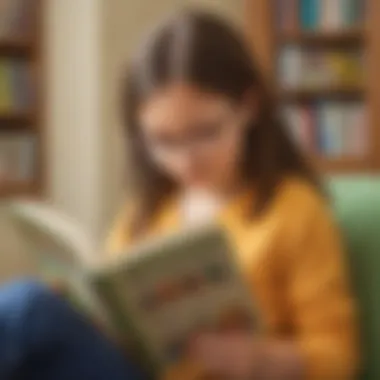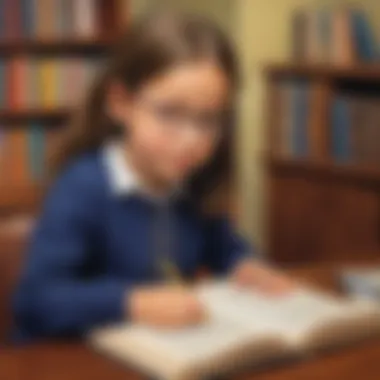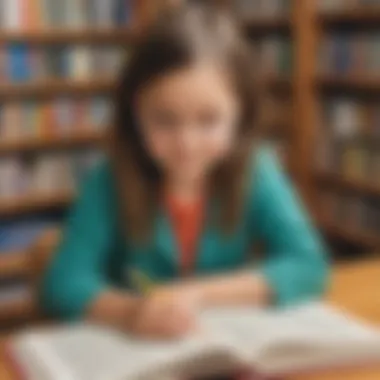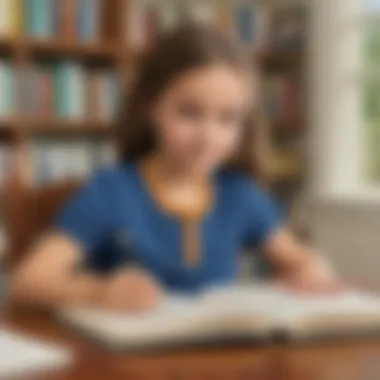Essential Reading Guide for 2nd Graders: Tips for Parents


Intro
Understanding reading expectations for a second grader is crucial for parents. At this age, children typically have developed basic reading skills and are ready to engage with more complex texts. Their cognitive and emotional development plays a significant role in their reading abilities. Selecting the right materials can help to foster both a love for reading and enhance their critical thinking skills.
Young readers can benefit from a rich variety of genres, including fiction, non-fiction, poetry, and more. Each genre plays a unique role in promoting different skills and understanding. This guide aims to provide insights, recommendations, and practical strategies for parents to support their children’s reading journey.
Creative Activities
Creative activities can greatly enhance a child's reading experience. Engaging in crafts related to books offers a hands-on understanding of stories and characters. Here are some ideas for parents to consider:
Craft Ideas
- Character Puppets: Use paper bags and art supplies to make puppets of their favorite story characters.
- Story Maps: Create a visual map of the plot using drawings and labels. This helps children organize their thoughts and understand the narrative structure.
- Book Cover Art: Encourage kids to design a new cover for a book they read. This sparks imagination and a personal connection to the reading material.
Step-by-Step Guides
1. Character Puppets
- Gather paper bags, markers, scissors, and glue.
- Help your child choose their favorite character from a book.
- Using markers and craft materials, create the character on the bag.
- Encourage them to enact scenes using their puppets to reinforce story comprehension.
2. Story Maps
- Draw a large outline on a paper.
- Identify key events in the story and illustrate them in sequential order.
- Discuss the map with your child, asking them to explain their choices.
Educational Value
These activities support literacy skills in a fun, interactive way. Crafting encourages creativity and boosts comprehension. Children not only enjoy these activities but also understand stories better.
Fun Quizzes
Quizzes can be an excellent way to reinforce what children have read. They can provide that little nudge of motivation and engagement that some kids need.
Quiz Topics
- Comprehension
- Vocabulary
- Plot Analysis
Question Types
Questions may include:
- Multiple Choice: Simple yet effective in assessing specific knowledge.
- True or False: Great for testing understanding of the material.
- Short Answer: This allows children to express their thoughts in a concise manner.
Knowledge Reinforcement
By taking quizzes, children solidify their understanding of the texts they read. It engages critical thinking, allowing them to recall and reflect on their readings.
Fact-Based Articles
Reading non-fiction is a powerful way to broaden a child's knowledge base. Fact-based articles can capture their interest and provide insights into various subjects.
Topics
Articles can cover a wide range, including:
- Animals
- Space
- History
Engaging Content
These articles often present facts in a digestible way. They can include images, diagrams, or fun facts, keeping children entertained while learning.
Understanding Second Grade Reading Goals
Understanding the reading goals for second graders is crucial for parents who wish to support their children's literacy development. At this stage, children transition from learning to read to reading to learn. This shift is significant, as it lays a foundation for future academic success. Parents should pay attention to various aspects of reading that align with their child’s cognitive and emotional growth.


Reading is not only about recognizing words but also about comprehending the text. When children engage with reading materials that challenge their skills, they develop critical thinking. It’s essential to select books that push their boundaries without causing frustration.
Cognitive Development in 2nd Graders
In second grade, cognitive development is characterized by improvements in language processing, memory retention, and analytical skills. Children begin to understand more complex sentence structures and vocabulary. They can follow stories that involve multiple characters and plots. This cognitive maturity allows for deeper engagement with reading material.
Key aspects of cognitive development are:
- Expanded vocabulary: Children learn new words through reading and conversation. A diverse range of books helps them encounter varied language.
- Improved comprehension: The ability to summarize and discuss stories indicates progress in understanding.
- Critical thinking: Asking questions about a story fosters a child's analytical skills, enabling them to form opinions and make inferences.
Overall, the cognitive development during this stage supports a child’s ability to read with understanding and enjoyment.
Literacy Milestones for 2nd Graders
Literacy milestones serve as benchmarks for second graders, guiding parents in evaluating their child's progress. Children typically reach several key milestones within reading by the end of second grade:
- Fluent reading: By this age, children can read grade-level texts with greater fluency.
- Comprehension skills: They start answering comprehension questions and retelling stories in their own words.
- Engaging with different genres: Exposure to various genres, such as fiction and non-fiction, enriches their reading experience and knowledge.
Tracking these literacy milestones not only showcases academic development but also highlights areas where further support may be needed. For instance, if a child struggles with comprehension, parents can provide books that feature simple narratives while encouraging discussion to build understanding.
It is critical for parents to engage with their child's reading journey, as early support can cultivate a lifelong love for literature.
Genres Suitable for 2nd Graders
Selecting appropriate genres for second graders is a crucial aspect of fostering a love for reading. At this stage, children are exploring their interests and developing their comprehension skills. Different genres offer unique benefits that can cater to their evolving cognitive abilities. It is important to understand how each genre can contribute to a child’s literacy development.
Fiction
Fiction books are a great way for second graders to explore imaginary worlds and diverse characters. This genre fosters creativity and allows children to empathize with different experiences. Reading stories helps improve their comprehension skills as they must follow plots, understand character motivations, and think critically about resolutions.
Some popular fiction series for this age group include:
- Magic Tree House by Mary Pope Osborne
- Junie B. Jones by Barbara Park
- Geronimo Stilton by Elisabetta Dami
These stories often include engaging characters and themes that resonate with young readers, encouraging them to think beyond their reality.
Non-Fiction
Non-fiction books play an essential role in educating second graders about the real world. They provide factual information on various topics ranging from animals to space exploration. This genre can boost children's curiosity and encourage a love for learning.
Among the recommended non-fiction reads are:
- National Geographic Little Kids First Big Book of Why by Amy Shields
- This Is How We Do It: One Day in the Lives of Seven Kids from Around the World by Matt Lamothe
- The Magic School Bus series by Joanna Cole
These titles not only cater to children’s thirst for knowledge but also develop their analytical and retention skills.
Poetry
Poetry introduces children to rhythm, rhyme, and creative language. It helps improve language skills, vocabulary, and listening abilities. The concise nature of poems encourages children to think about word choice and expression. It can be a gateway to deeper discussions about feelings and experiences.
Recommended poetry books include:
- A Child's Introduction to Poetry by Michael Driscoll
- Where the Sidewalk Ends by Shel Silverstein
- Read-Aloud Rhymes for the Very Young by Jack Prelutsky
These collections often spark imagination and inspire young minds to create their own poetic expressions.
Graphic Novels
Graphic novels are increasingly popular among second graders. They combine visual storytelling with text, making reading more accessible and engaging for reluctant readers. The illustrations help children decipher complex narratives and build context.
Some notable suggestions are:
- Dog Man series by Dav Pilkey
- Smile by Raina Telgemeier
- Amulet series by Kazu Kibuishi


Thus, graphic novels can help promote engagement and a sustained interest in reading, offering a stylish alternative to traditional books.
By introducing various genres, parents can guide their children to discover their preferences and passions in reading, ultimately fostering a lifelong love for literature.
Identifying Age-Appropriate Books
Identifying age-appropriate books is crucial for fostering reading skills in second graders. Selecting literature that aligns with their cognitive abilities and emotional development can enhance comprehension and enjoyment. Books that match their reading levels motivate continued engagement with texts. This practice helps parents invest in their children's reading journey, promoting both academic achievement and a passion for literature.
Recommended Reading Lists
Curating recommended reading lists serves as a practical tool for parents. These lists can include various genres suitable for second graders, ensuring a well-rounded reading experience.
Here's a brief outline of notable titles:
- "The Cat in the Hat" by Dr. Seuss
- "Junie B. Jones" series by Barbara Park
- "Magic Tree House" series by Mary Pope Osborne
- "Charlotte's Web" by E.B. White
- "Fly Guy" series by Tedd Arnold
These selections often feature engaging plots and relatable characters. They also have varying levels of linguistic complexity and thematic content. Parents can find such lists through educational websites or public library resources. Offering diverse options helps nurture a love for reading, encouraging children to explore multiple perspectives.
Consideration of Reading Levels
Reading levels are vital in helping children succeed. When selecting books, parents should assess the readability and complexity of texts. Many books are labeled with specific reading levels, making it easier to choose appropriate options.
Moreover, understanding key indicators of reading ability can assist in this process:
- Recognizing familiar words: Children should be able to read and comprehend sight words and frequent vocabulary.
- Grasping themes: Texts should have themes that resonate with their experiences.
- Understanding sentence structure: Books should feature sentences that match the complexity of what children can read.
A balanced approach will prevent frustration and enhance confidence in reading. Resources like the Lexile Framework or STAR Reading can help parents gauge their child's reading abilities more accurately. Ultimately, focusing on reading levels and interests is paramount for advancing literacy skills in second graders.
The Role of Interests in Reading Choices
Understanding a second grader's personal interests is crucial in shaping their reading experiences. Children are more likely to engage with texts that resonate with them, capturing their attention and fostering an intrinsic desire to read. The intersection of personal interest and reading can lead to deeper comprehension and retention of information.
Exploring Personal Interests
Personal interests vary greatly among children in the second grade. Some may be fascinated by dinosaurs, while others prefer stories about space or everyday life. Recognizing and supporting these interests can greatly enhance their reading journey.
- Parental Guidance: Parents should engage in conversations with their children about their preferences. This opens a dialogue where children feel valued and motivated to express what they like.
- Book Selection: Seek out books that align with those interests. For instance, if a child loves animals, books like National Geographic Little Kids First Big Book of Animals can be both educational and enjoyable.
Using a mix of genres based on their interests can provide a well-rounded reading experience, allowing the child to explore various topics while still focusing on what excites them the most.
Impact on Engagement
The impact of personal interest on a child's engagement in reading cannot be overstated. When children are interested in the topic, they are more inclined to pick up a book and spend time with it. This engagement is vital for several reasons:
- Deeper Comprehension: When a child is passionate about the subject matter, they inherently invest more cognitive resources into understanding the content. This can lead to improved retention and critical thinking about the material.
- Confidence Building: Positive reading experiences can help build self-esteem. Children who enjoy reading are more likely to participate in discussions about the story, enhancing their verbal skills.
- Encouragement of Lifelong Reading Habits: Books that align with interests can lay the groundwork for a love of reading that extends beyond the classroom.
Supporting Literacy at Home
Supporting literacy at home plays a critical role in how children develop their reading skills. This is especially true for second graders, who are in a pivotal stage of their cognitive and emotional growth. A supportive home environment can lead to greater engagement with reading materials, boosting both comprehension and retention. Parents and caregivers can create conditions that foster interest in literature. By actively participating in their child's reading journey, they set the foundation for lifelong learning.
Creating a Reading Environment
A reading environment is crucial for encouraging young readers. This includes a designated, comfortable space with access to a variety of books. It should be well-lit and quiet, free from distractions. Having a mix of genres—fiction, non-fiction, poetry, and graphic novels—can cater to varied interests. Positioning books within easy reach inspires children to explore on their own.
Additional elements can enhance this environment:
- Accessibility: Place books at their eye level.
- Fostering Comfort: Include pillows or rugs where they can sit and read.
- Routine: Make reading a part of the daily schedule, such as before bedtime.
Creating a space dedicated to reading reinforces its importance in a child's life, indirectly urging them to engage more with their literature.
Reading Together: Methods and Techniques
Reading together is an intimate experience that can significantly impact a child's literacy development. It nurtures a connection between parent and child, making reading an enjoyable, shared activity. There are various methods and techniques parents can apply to enhance these reading sessions.


- Interactive Reading: Ask questions during the reading to encourage comprehension. For example, “What do you think will happen next?” This kind of interaction keeps children engaged.
- Expressive Reading: Use different voices for characters or adjust tone and pace, making the story come alive. This can help capture the child's imagination and make the reading session more enjoyable.
- Follow Up Discussions: After reading, talk about the book. Discuss favorite characters or what they learned. This reinforces retention and comprehension of the material.
- Make it Routine: Set a specific time each day for reading. Consistency helps develop habits and a love for books over time.
Engaging young minds through shared reading not only improves literacy but also strengthens the bond between parent and child.
By utilizing these methods, parents can turn reading into a cherished activity, promoting enthusiasm for literature and critical thinking skills in their second graders.
Utilizing Educational Resources
Utilizing educational resources effectively plays a significant role in enhancing a second grader's reading journey. These resources provide not only access to diverse literature but also stimulate learning through interactive platforms and community engagement. This section will explore key educational tools and the benefits they bring to children's literacy development.
Online Learning Platforms
In today's digital age, online learning platforms have become indispensable tools for engaging young readers. Platforms like ABCmouse or Epic! offer a vast array of age-appropriate books, games, and activities that cater to various learning styles. These resources are particularly valuable for second graders, who benefit greatly from visual and auditory stimuli in addition to traditional reading.
Benefits of Online Learning Platforms
- Variety of Content: Online platforms provide books across multiple genres, ensuring children find content that aligns with their interests.
- Interactive Features: Many platforms include quizzes and games that reinforce reading comprehension. This makes learning fun and encourages active participation.
- Flexibility: Parents can easily tailor their child's reading experience based on specific needs, be it difficulty level or preferred topics.
- Accessibility: With the possibility to access resources anywhere, children can engage in reading at home or on the go.
For example, Starfall offers engaging stories that help children with phonics while also introducing them to various literary themes.
Local Libraries and Community Programs
Local libraries and community programs are invaluable resources for nurturing a child's reading habits. Libraries often have sections specifically dedicated to younger readers, loaded with engaging books that capture the imagination of second graders. Many also provide programming that encourages reading through interactive storytelling sessions and author visits.
Benefits of Local Libraries and Community Programs
- Free Access: Libraries offer free borrowing privileges, making it easy for parents to expose their children to a range of literature without financial burden.
- Community Engagement: Programs often foster community togetherness, allowing children to meet peers who share similar interests in reading.
- Guidance from Professionals: Librarians can provide personalized book recommendations based on a child’s interests and reading level.
- Special Events: Many libraries host special events like reading challenges or themed storytime, boosting excitement for reading.
Monitoring Progress and Development
Tracking the progress of your second grader's reading skills is essential. It provides insight into their current abilities and highlights areas that need improvement. Monitoring progress not only helps in identifying strengths and weaknesses but also encourages a continuous reading journey. Children are in a critical phase of literacy development during second grade, which makes this monitoring phase pivotal for their growth and future learning.
Assessing Comprehension and Retention
Assessing comprehension is a vital component of understanding how well your child is absorbing what they read. This can involve asking simple questions about the story. You might inquire about the main character, the setting, or the plot. These questions will gauge their grasp of the material. Also, consider asking them to retell the story in their own words. This can solidify their understanding and improve their retention. Regular assessments provide valuable feedback, guiding parents on how to support their children's reading journey.
Engaging in Discussions
Engaging in discussions about books can significantly enhance comprehension and enjoyment. When you read together, pause to talk about the story. Ask open-ended questions that prompt your child to think deeper about the content. For example: What do you think will happen next? or How would you feel if you were in that situation? Such conversations not only improve comprehension but also develop critical thinking skills. Encouraging children to express their thoughts fosters a deeper love for literature.
Adapting to Changing Interests
Children's interests can shift rapidly at this age. A book that captivated them last month might not hold their attention today. It is crucial to adapt and respond to these changing interests. Regularly check in with your child about their preferences in genres or stories. If they show an interest in dinosaurs, for instance, look for books that incorporate that theme. Keeping reading material fresh and aligned with their interests fosters continuous engagement and passion for reading.
Understanding your child’s reading habits and preferences is not just beneficial for their current skills but lays a foundation for lifelong learning.
By monitoring your child’s progress, assessing comprehension, encouraging discussions, and adapting to their shifting interests, you are not only enhancing their reading skills but also promoting critical thinking and a lasting love for literature.
Epilogue
Reading is more than just a skill. It lays a very important foundation for academic and personal success. Understanding the reading expectations for second graders helps parents and caregivers guide their children in meaningful ways. Children develop critical thinking, empathy, and creativity through diverse literature.
By providing appropriate materials, parents foster a love for reading early on. This ensures children are not only engaged but also motivated to explore various subjects. Developing a reading habit can have long-term benefits for their educational journey.
"Reading opens the doors to knowledge and imagination."
The Long-term Benefits of Early Reading
Early reading plays a crucial role in a child’s cognitive development. Words and ideas encountered in books expand vocabulary. A rich vocabulary is essential for effective communication and comprehension in later grades. Second graders who read regularly are more likely to perform better in all subjects as they progress through school.
Another advantage of early reading is enhanced social skills. As children read stories about different characters and scenarios, they learn about diverse perspectives. This ability to understand others promotes empathy. Empathy is a foundational skill for well-rounded developmental growth.
Additionally, the habit of reading promotes concentration. Children learn to focus on the narrative and retain information. These skills become valuable as they take on more complex texts in higher grades. Thus, fostering a reading routine invites them into a world of ideas that helps them become independent thinkers.
Encouraging Lifelong Learning
Instilling a passion for reading in second graders sets the stage for lifelong learning. Children who enjoy reading are more inclined to seek knowledge throughout their lives. As they grow older, they will have the drive to explore various fields such as science, history, and the arts. This thirst for knowledge often leads to higher academic achievements.
Moreover, learning continues beyond the classroom. Reading provides a gateway to discovering interests outside of school. Whether it’s following new trends in technology or diving into classic literature, the opportunities are endless. When children learn to enjoy reading, they develop curiosity. This curiosity leads to questions that fuel further exploration of topics they find intriguing.
In summary, early reading is fundamental in shaping not only academic success but also a love for lifelong learning. In cultivating these habits, parents create a lasting impact on their children’s intellectual and emotional development.







